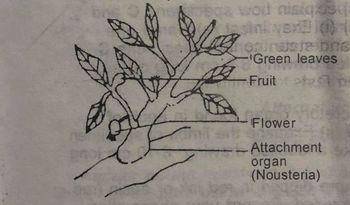
(a) identify specimen D without giving reason (b) (i) State two observable features of specimen D which indicate its mode of nutrition (b) (ii) What is the mode of nutrition cf specimen D? (c) Make a labelled drawing to show features of biological importance of the specimen (d) (i) Examine and identify without reasons specimens E and F
Explanation
(a) Specimen D is a parasitic plant (Cassythafiliformis) or dodder. In some schools, it could be a semiparasitic plant-like mistletoe
| Organism | Mode of Nutrition | Observable features |
|
Dodder (Cassythafiliformis) |
Completely parasitic or heterotrophic |
(i) Yellow in colour. It has no leaves. It has no chlorophyll (ii) Presence of haustoria or Presence of haustoria or leaves. sucker or attachment organ |
|
Mistletoe |
Parasitic or semi-parastic or heterotrophic or autotrophic |
(i) It has green leaves or chlorophy Il (ii) Presence of haustoria or sucker or attachment organ |
(d)(i) Specimen E is a soldier termite. Specimen F is a grasshopper (ii) Structural adaptations and their significance. Soldier termites have enlarged heads for bearing strong mouth parts of mandibles adapted for offence and defence. The mouth parts are also adapted to vegetable diet. Grasshoppers have biting or chewing mouth parts adapted for chewing vegetable diet. They also have strong hind limbs for jumping away from their enemies. In addition, they have wings for flight

